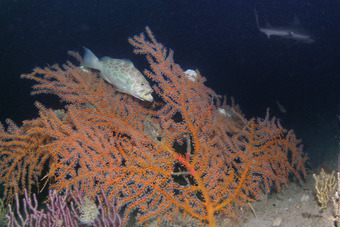Publications:
Silva et al. 2016
Pathologies in over 400 octocoral and antipatharian colonies were quantified in the aftermath of the DWH oil discharge. Observations were made in September 2011 at water depths of 65 to 75 meters in the Pinnacle Reef trend area offshore from Mississippi and Alabama, Gulf of Mexico, using a digital macro camera deployed from an ROV to examine the coral populations for injury at two principal sites: Alabama Alps Reef (AAR) and Roughtongue Reef (RTR). Taxa observed to exhibit injury included gorgonian octocorals Hypnogorgia pendula, Bebryce spp., Thesea nivea, and Swiftia exserta, the antipatharian Antipathes atlantica, and the sea whips Stichopathes sp., and Ellisella barbadensis. The most common type of injury was a biofilm with a clumped or flake-like appearance covering sea-fan branches. Extreme injuries were characterized by bare skeletons, broken and missing branches. Comparing the 2011 results to previous photo surveys of the same study sites between 1997 and 1999, we found significantly more occurrences of injury in 2011 among taxa with growth forms >0.5 m. We hypothesize that Tropical Storm Bonnie facilitated and accelerated the mixing process of dispersant-treated hydrocarbons into the water column, resulting in harmful contact with coral colonies at mesophotic depths. Analysis of total polycyclic aromatic hydrocarbon (tPAH) concentrations in sediments at AAR and RTR found levels elevated above pre-discharge values, but orders of magnitude below toxicity thresholds established for fauna in estuarine sediments. The tPAH concentrations measured in octocoral and echinoderm tissue samples from AAR and RTR were detectable (mean values ranged from 51–345 ppb); however, bioeffect thresholds do not currently exist with which to evaluate the potential harm these levels may cause. Our findings indicate that coral injuries observed in 2011 may have resulted from an acute, isolated event rather than ongoing natural processes.
64- 130 m
Mesophotic “mentions”
12 x (total of 6478 words)
Classification
* Presents original data
* Focused on 'mesophotic' depth range
Fields
Ecology
Disturbances
Long-term monitoring
Focusgroups
Octocorallia (Soft Corals)
Antipatharia (Black Corals)
Other invertebrates
Locations
USA - Gulf of Mexico
Platforms
Remotely Operated Vehicle (ROV)
Coring / drilling
Surface-deployed sensors and samplers


